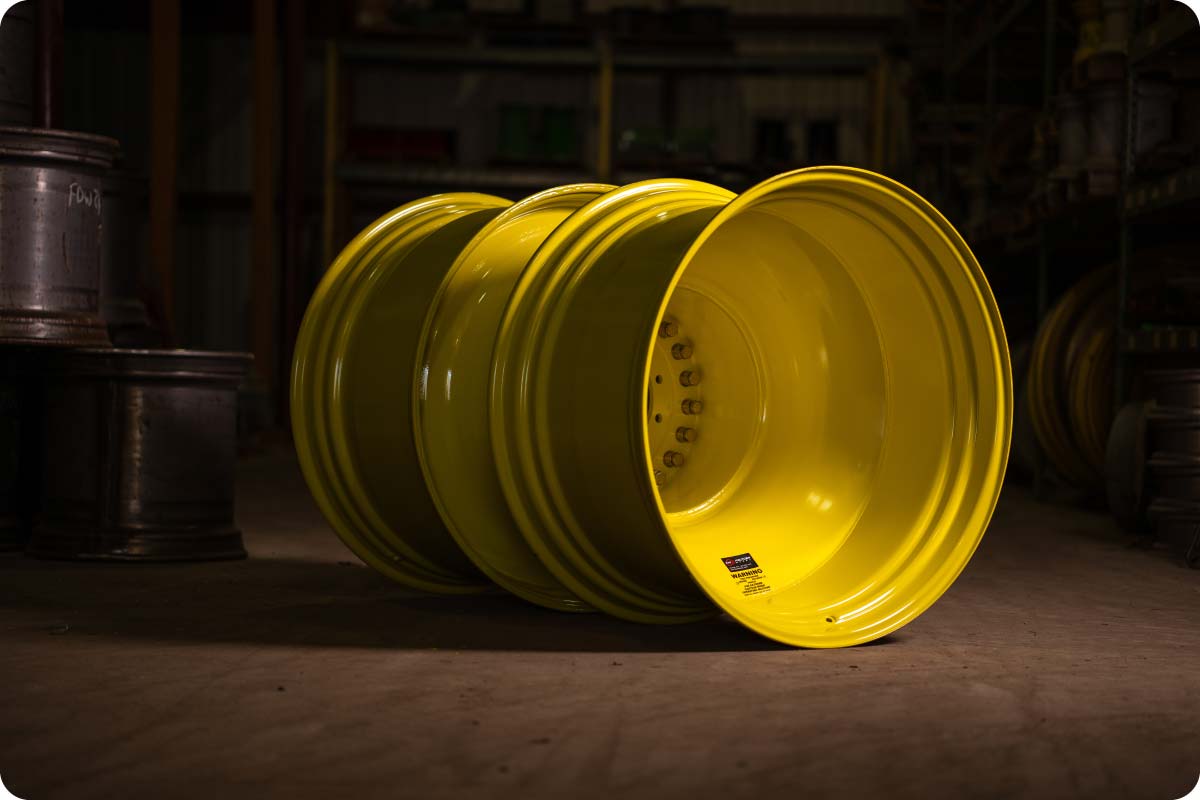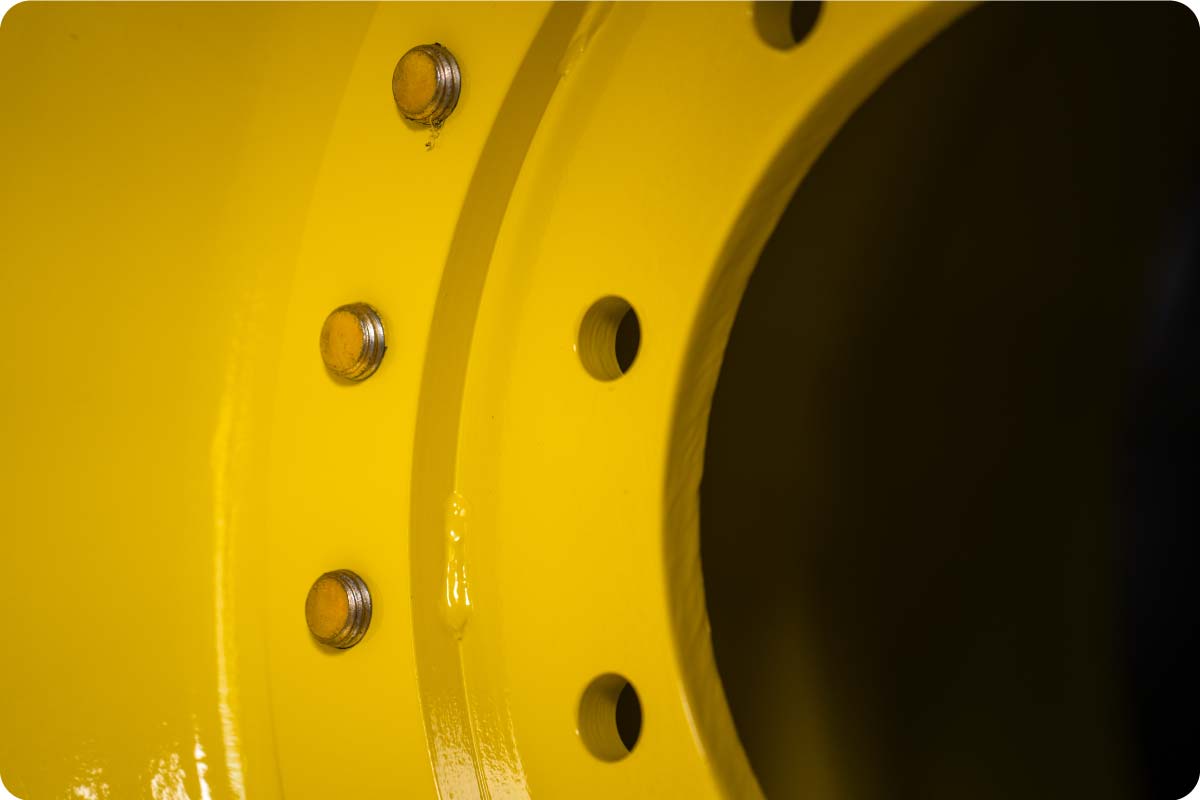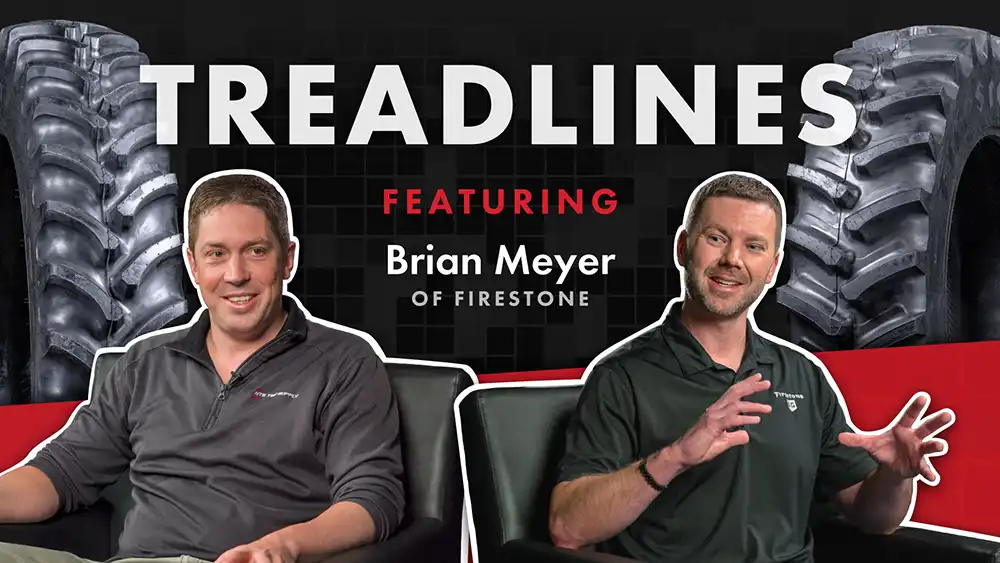At NTS Tire Supply, we love to talk about tires. Today’s modern farm tires are much better at limiting compaction, delivering a better ride, and providing better grip than past generations of rubber. But you can’t afford to forget about the hardware. Different types of wheel hardware can have a big impact on the efficiency of your harvest.

The wrong (or less ideal) setup can leave you stranded with a time-consuming breakdown. If you don’t enjoy a time out because your hired hand harvested the line fence, you’re not going to like a forced break because of cracked rims either. Choosing a better (more ideal) dual setup can help ensure a smooth harvest—at least in the tire and wheel department.
Option 1. Dolly Duals: Lowest Priced. Lowest Performance.

Stock combines roll off the assembly line with dolly duals. They come standard with a 2-inch spacer between the wheels so you can straddle the rows. Some growers upgrade to a 5-inch (or 8-inch) spacer to help the duals better clear mud in wet conditions. With these wider spacers, you won’t straddle the rows. Tire sizes with dolly duals range from 480/80R38s (18.4R38) to 650/85R38s.
Want to avoid a time-consuming and costly breakdown in the field? We believe that it’s worth your money to upgrade from stock dolly duals to one of the options listed below. In our experience, dolly duals have the most cracking issues. For red power fans, the news is even worse: Case IH wheels have 20 lug holes versus 10 lug holes on John Deere machines. More bolt holes mean more opportunities for cracking.
After listening to customer feedback, we don’t believe that stock duals are up to the demands of supporting today’s massive machines. However, if you have a smaller combine that needs duals, these could still be a viable option.

Option 2. Straddle Duals: A Stronger Design

You don’t actually straddle the rows with straddle duals. But you will experience a lot fewer cracking issues with straddle duals thanks to their design. Straddle duals incorporate 2 bolt circles (instead of the one bolt circle with dolly duals) that dissipate the stress placed on the wheel over a much larger surface area. The inner bolt circle bolts the inner wheel onto the combine hub. The outer bolt circle bolts the two wheels together. Available sizes with straddle duals range from 710/70R38s to 900s.
With this setup you’ll have 10 to 12 inches of space between the wheels for better mud flow in wet conditions. We generally recommend that growers install a frame extension when switching to straddle duals to gain more clearance between the combine and inner wheel. And mud scrapers are a good idea if you plan to run in wet conditions.
Straddle duals are more expensive but can help you avoid most costly in-field breakdowns resulting from cracked rims.
Even Tougher: Straddle Dual HDs Built by NTS

We make our own version of straddle duals in-house that are designed for class 9 and larger combines. They are built specifically for today's heaviest combines:
- 20% thicker steel on main wheel over O.E.
- A one-piece spun flange and tube eliminates welds that commonly fail on regular duals.
- More holding power with larger diameter tube/flange and 0.75" thicker threaded ring (on 20-hole wheels).
- Bead flange reinforcements on main wheel.
- Durable powder coat finish.
If you’re interested in protecting your harvest uptime and want to roll with wheels that will withstand fall’s toughest conditions for seasons to come, invest in a set of our HD straddle duals.


Option 3. Expanded-Band Straddle Duals

We haven’t seen any cracking issues with expanded-band straddle duals. Similar to the straddle dual setup, expanded-bands have 2 bolt circles. However, on these setups, the outer bolt circle, which holds the two wheels together, is even larger. Expanded-band straddle duals also incorporate studs and gussets inside the wheel for additional reinforcement. These design features further distribute the stress over a larger area to virtually eliminate cracking issues.
Size options range from 480/80R38 (18.4R38) to 800/65R32 (30.5R32). Some combines will require a 6- or 12-inch frame extension with this setup. And you should also invest in scrapers if you’re running expanded-band straddle duals through mud. These duals have a larger-diameter center drum between the wheels, which means less clearance between the hardware and the ground and a greater chance of mud buildup in wet conditions.
With a quality dual setup you’re investing more up front to outfit your combine, but you’ll experience fewer (or no) cracking issues in the field. And when every minute counts—when you’re racing the weather and the seasons—avoiding cracked wheels is worth every penny you’ve invested.

Option 4. No Duals: One BIG Tire Rolls Over the Competition
If you haven’t had time to read our article on low sidewall (LSW) tires, here’s a summary: We think LSWs can be a better option than dual setups on combines. These massive tires (1100, 1250, or even 1400 width), when mounted in place of a dual setup, offer:
- Excellent traction
- More stable/secure handling
- Shallower ruts
- Better cleanout prior to road travel
- Narrower overall width for road travel
- No cracked rims
We encourage you to read our LSW Super Singles: Are They Better than Duals? article for the complete story. In the meantime, let’s just say that the majority of our customers who have switched from dual setups to LSW singles have told us that they will never go back to duals.

We know that LSW super singles aren’t for everyone, which is why we offer virtually every combine tire setup out there, both in duals and singles. If you need help determining the best tire setup for your combine, contact our product support team at (888) 787-3559.
If you want to help ensure a smooth, breakdown-free harvest this fall, consider upgrading your combine from stock dolly duals to one of the other three options listed above. We don’t often get a chance to give wheel hardware its due, but this is one time where the right hardware can make the difference between rolling along with a smooth harvest or waiting for the service truck.

.png)
.jpg)



















